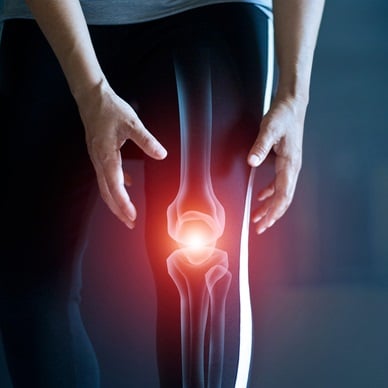Aerobic vs. Anaerobic Exercise: Benefits & What’s Better

No, all exercise is not created equal, especially when it comes to aerobic vs. anaerobic exercise. A lot of factors determine which form of exercise is appropriate for you. Some of these factors include things like your goals, level of fitness, any physical limitations you may have, and your time frame. So, which type of exercise should you do: aerobic or anaerobic? The answer is both, and here’s why.
Aerobic vs. Anaerobic Exercise: What’s the Difference?
Aerobic vs. anaerobic exercise use different mechanisms for energy. A movement will either be longer and less intense or involve short bursts of higher-intensity work. How the exercise is performed helps determine whether the action is aerobic or anaerobic.
Aerobic type exercise is movement that uses oxygen. In fact, the term “aerobic” means “with oxygen.” According to the American College of Sports Medicine (ACSM), aerobic exercise refers to rhythmically moving large muscle groups. Oxygen-rich blood is sent to the muscles you’re working to help you power through your movements.
When doing aerobic exercise, your body relies on that oxygen to help burn carbohydrates. Carbohydrates are the first choice of fuel for aerobic exercise. Then, once you’ve tapped those resources, your body will switch to burning fat for fuel.
You may have heard aerobic exercise referred to as “cardio,” which is short for “cardiovascular.” Although aerobic exercise has many benefits, this type of exercise mainly benefits your heart, thus the “cardio” moniker.
Anaerobic exercise, on the other hand, means “without oxygen” and provides your body with fuel through a different mechanism than aerobic exercise. Since the exercises don’t require oxygen, anaerobic movements need to get their fuel in a different way. Anaerobic exercise leads to a breakdown and use of glucose supplies stored in both muscle tissue and your bloodstream. Because this offers shorter bursts of energy than aerobic (oxygen-fed) exercise, anaerobic exercise is not designed for long durations. Rather, it’s typically comprised of quicker, more intense movements.
And while aerobic exercise’s main benefactor is cardiovascular health, the principal purpose of anaerobic exercise is to build muscle and strength.
Benefits of Aerobic Exercise
All exercise has massive benefits—physically and psychologically—but aerobic exercise focuses mainly on the following benefits:
- Burns body fat
- Boosts heart health
- Improves your cholesterol
- Stabilizes blood sugar
- Increases endurance
- Expands lung capacity
- Lowers your blood pressure
- Produces feel-good natural antidepressants called endorphins
- Keeps your resting heart rate low
Benefits of Anaerobic Exercise
Anaerobic exercise also has a host of benefits, including:
- Builds and strengthens bones
- Builds metabolically active muscle tissue
- Strengthens and “tones” muscles
- Promotes the loss of body fat
- Improves power
- Improves posture
- Assists with better balance
- Is a great way to work off stress
Choosing Exercise Based on Goals
Sometimes it’s easiest to determine which form of exercise to do based on goals. Are you trying to lose body fat? Are you interested in getting stronger, running a marathon, or improving your endurance? Taking your goals into account can help you decide what’s better for you: aerobic vs. anaerobic exercise.
If your goals include a lithe body that can endure long bouts of physical activity or your aim is optimal heart health, fat burning, or general well-being, then aerobic exercise is a great choice for you.
If your ultimate goal is to build a strong, toned physique, be able to carry your groceries into the house, prevent falls as you age, and keep your bones and muscles strong and your metabolism active, then anaerobic exercise is for you.
Better yet, if your fitness and health goals are multi-faceted, the best option is to include both forms of exercise in your weekly routine to take advantage of the benefits of each. It doesn’t have to be a question of aerobic vs. anaerobic exercise: it should be a matter of using both forms of exercise to your advantage.
Types of Aerobic Exercises
Aerobic exercise can differ greatly in intensity and the amount of endurance, skill, and fitness required to perform it. However, in general, aerobic exercise can be done for longer periods to build endurance.
- Mild to moderate steady-state movements, such as walking, jogging, or aerobic classes
- Vigorous intensity endurance exercises, like swimming, spinning, running, or stair climbing
- Sports that incorporate running, like tennis, soccer, or basketball
Types of Anaerobic Exercises
Anaerobic exercise will be movements that are shorter and more intense. The body can’t sustain the activity for more than a few minutes at a time.
- High-Intensity Interval Training like sprinting and Tabata (the repeated starting and stopping elements prevent this type of exercise from being purely aerobic)
- Weight lifting, including circuit training (which can include a cardio element in between sets) and powerlifting
- Calisthenics and Plyometrics—these types of movements are short but intense and are generally considered anaerobic
How Much Aerobic vs Anaerobic Exercise Should You Do?
Based on recommendations by the World Health Organization, the physical activity guidelines for healthy adults are:
• A minimum of 150 – 300 minutes of moderate-intensity aerobic physical activity per week.
Or …
• At least 75 – 150 minutes of vigorous-intensity aerobic physical activity per week.
Also …
• Include muscle-strengthening activities at moderate intensity or greater for at least two to three days a week.
What’s better when it comes to exercise: aerobic vs. anaerobic exercise? Since these forms of exercise use different mechanisms in the body to supply fuel and can help strengthen different systems, it’s important to include both. Yes, some activities can cross over into both areas depending on intensity and length of workout, but purposefully doing some aerobic and some anaerobic exercise several times a week is the best formula for success.





 US Doctor: "Eating This Every Day Can Snap You Into Ketosis"
US Doctor: "Eating This Every Day Can Snap You Into Ketosis" 3 Key Nutrients to Help Lubricate Your "Tin Man" Joints
3 Key Nutrients to Help Lubricate Your "Tin Man" Joints AVOID Plant-Based Protein Powders (unless...)
AVOID Plant-Based Protein Powders (unless...)

